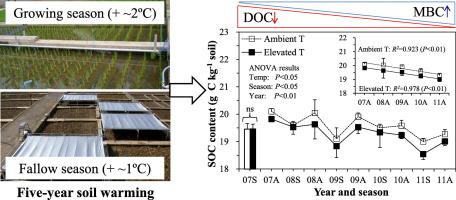Science of the Total Environment ( IF 8.2 ) Pub Date : 2020-11-20 , DOI: 10.1016/j.scitotenv.2020.143845 Shuirong Tang , Weiguo Cheng , Ronggui Hu , Julien Guigue , Satoshi Hattori , Keitaro Tawaraya , Takeshi Tokida , Minehiko Fukuoka , Mayumi Yoshimoto , Hidemitsu Sakai , Yasuhiro Usui , Xingkai Xu , Toshihiro Hasegawa

|
Soil temperature is an important determinant of carbon (C) and nitrogen (N) cycling in terrestrial ecosystems, but its effects on soil organic carbon (SOC) and total nitrogen (TN) dynamics as well as rice biomass in rice paddy ecosystems are not fully understood. We conducted a five-year soil warming experiment in a single-cropping paddy field in Japan. Soil temperatures were elevated by approximate 2 °C with heating wires during the rice growing season and by approximate 1 °C with nighttime thermal blankets during the fallow season. Soil samples were collected in autumn after rice harvest and in spring after fallow each year, and anaerobically incubated at 30 °C for four weeks to determine soil C decomposition and N mineralization potentials. The SOC and TN contents, rice biomass, dissolved organic carbon (DOC) and microbial biomass carbon (MBC) concentrations were measured in the study. Soil warming did not significantly enhance rice aboveground and root biomasses, but it significantly decreased SOC and TN contents and thus decreased soil C decomposition and N mineralization potentials due to depletion of available C and N. Moreover, soil warming significantly decreased DOC concentration but significantly increased MBC concentration. The ratios of C decomposition potential to N mineralization potential, decomposition potential to SOC, and N mineralization to TN were not affected by soil warming. There were significant seasonal and annual variations in SOC, C decomposition and N mineralization potentials, soil DOC and MBC under each temperature treatments. Our study implied that soil warming can decrease soil C and N stocks in paddy ecosystem probably via stimulating microbial activities and accelerating the depletion of DOC. This study further highlights the importance of long-term in situ observation of C and N dynamics and their availabilities in rice paddy ecosystems under increasing global warming scenarios.
中文翻译:

五年的土壤变暖改变了日本单一稻田中土壤碳氮的动态
土壤温度是陆地生态系统中碳(C)和氮(N)循环的重要决定因素,但它对水稻生态系统中土壤有机碳(SOC)和总氮(TN)动态以及水稻生物量的影响尚不完全了解。我们在日本的单季稻田进行了为期五年的土壤变暖实验。在水稻生长季节,用电热丝将土壤温度升高约2°C,在休耕季节用夜间隔热毯将土壤温度升高约1°C。每年秋天分别在水稻收获后的秋天和休耕后的春天收集土壤样品,并在30°C下厌氧孵育4周,以确定土壤C分解和N矿化的潜力。SOC和TN含量,水稻生物量,在研究中测量了溶解有机碳(DOC)和微生物生物量碳(MBC)的浓度。土壤变暖并未显着增强水稻的地上部和根系生物量,但由于有效碳和氮的消耗,土壤中的SOC和TN含量显着降低,从而降低了土壤碳的分解和氮矿化潜力。此外,土壤变暖显着降低了DOC的浓度,但显着增加MBC浓度。土壤变暖不影响C分解电位与N矿化电位的比,分解对SOC的电位和N矿化对TN的比。在每种温度处理下,SOC,C分解和N矿化潜力,土壤DOC和MBC都有明显的季节性和年度变化。我们的研究表明,土壤变暖可能通过刺激微生物活动和加速DOC的消耗而减少稻田生态系统中的土壤C和N储量。这项研究进一步强调了长期的重要性全球气候变暖情景下稻田生态系统碳,氮动态及其有效性的现场观测。











































 京公网安备 11010802027423号
京公网安备 11010802027423号